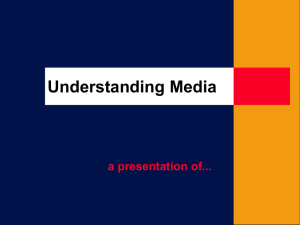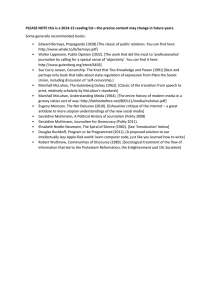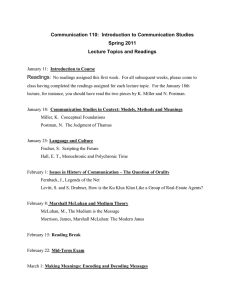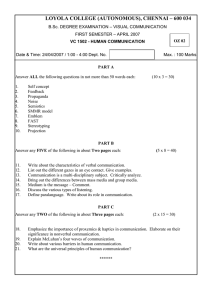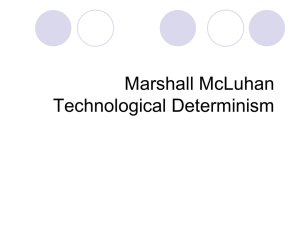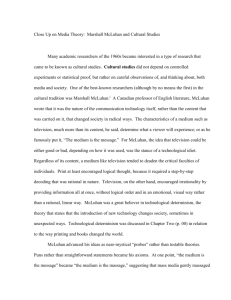Unlocking Perspective with Quick Response Codes
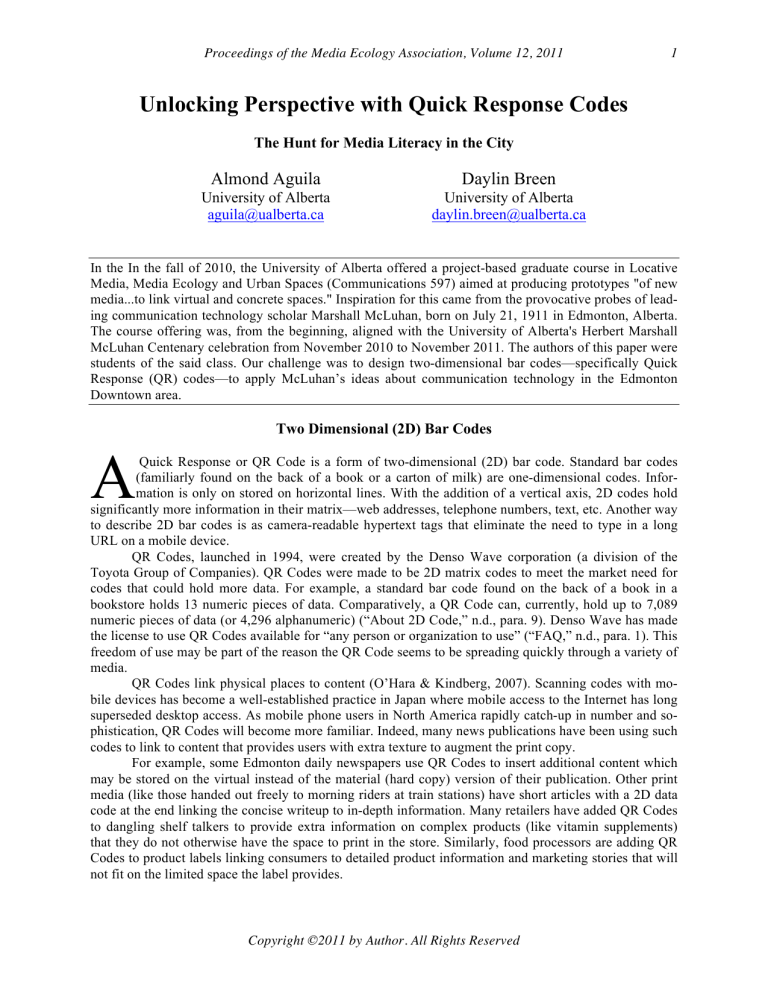
Proceedings of the Media Ecology Association, Volume 12, 2011
Unlocking Perspective with Quick Response Codes
The Hunt for Media Literacy in the City
Almond Aguila
University of Alberta aguila@ualberta.ca
Daylin Breen
University of Alberta daylin.breen@ualberta.ca
In the In the fall of 2010, the University of Alberta offered a project-based graduate course in Locative
Media, Media Ecology and Urban Spaces (Communications 597) aimed at producing prototypes "of new media...to link virtual and concrete spaces." Inspiration for this came from the provocative probes of leading communication technology scholar Marshall McLuhan, born on July 21, 1911 in Edmonton, Alberta.
The course offering was, from the beginning, aligned with the University of Alberta's Herbert Marshall
McLuhan Centenary celebration from November 2010 to November 2011. The authors of this paper were students of the said class. Our challenge was to design two-dimensional bar codes—specifically Quick
Response (QR) codes—to apply McLuhan’s ideas about communication technology in the Edmonton
Downtown area.
Two Dimensional (2D) Bar Codes
A
Quick Response or QR Code is a form of two-dimensional (2D) bar code. Standard bar codes
(familiarly found on the back of a book or a carton of milk) are one-dimensional codes. Information is only on stored on horizontal lines. With the addition of a vertical axis, 2D codes hold significantly more information in their matrix—web addresses, telephone numbers, text, etc. Another way to describe 2D bar codes is as camera-readable hypertext tags that eliminate the need to type in a long
URL on a mobile device.
QR Codes, launched in 1994, were created by the Denso Wave corporation (a division of the
Toyota Group of Companies). QR Codes were made to be 2D matrix codes to meet the market need for codes that could hold more data. For example, a standard bar code found on the back of a book in a bookstore holds 13 numeric pieces of data. Comparatively, a QR Code can, currently, hold up to 7,089 numeric pieces of data (or 4,296 alphanumeric) (“About 2D Code,” n.d., para. 9). Denso Wave has made the license to use QR Codes available for “any person or organization to use” (“FAQ,” n.d., para. 1). This freedom of use may be part of the reason the QR Code seems to be spreading quickly through a variety of media.
QR Codes link physical places to content (O’Hara & Kindberg, 2007). Scanning codes with mobile devices has become a well-established practice in Japan where mobile access to the Internet has long superseded desktop access. As mobile phone users in North America rapidly catch-up in number and sophistication, QR Codes will become more familiar. Indeed, many news publications have been using such codes to link to content that provides users with extra texture to augment the print copy.
For example, some Edmonton daily newspapers use QR Codes to insert additional content which may be stored on the virtual instead of the material (hard copy) version of their publication. Other print media (like those handed out freely to morning riders at train stations) have short articles with a 2D data code at the end linking the concise writeup to in-depth information. Many retailers have added QR Codes to dangling shelf talkers to provide extra information on complex products (like vitamin supplements) that they do not otherwise have the space to print in the store. Similarly, food processors are adding QR
Codes to product labels linking consumers to detailed product information and marketing stories that will not fit on the limited space the label provides.
1
Copyright ©2011 by Author. All Rights Reserved
2 Almond Aguila & Daylin Breen
Some art galleries, on the other hand, use QR Codes to provide the extra detail previously stored in bulky audio tour devices. For example, the Manchester Art Gallery tested QR Codes in its Remembering Slavery: Revealing History display. Visitors were able to use their mobile devices to visit webpages that “invite visitors to submit comments on six works on show, and listen to and read poems and comments on some of the objects” (Roger, 2008 para. 1). It is worth noting that many art galleries may not be friendly to patrons using their camera phones due to standard gallery copyright protecting rules that forbid photography in gallery spaces.
Related Literature
E
XPECTEDLY, scholarly work on QR Codes was initiated by engineers, communications technology designers, and computing experts. It is only in the last decade that a common interest in varied applications brought together other disciplines.
The versatility and availability of the QR Code, however, led to its increasing popularity in more techno-savvy societies such as Japan. Even so, scholars have only recently acknowledged its applications in marketing commercial products and services (Ebner, 2008; Dou & Li, 2008) and in enhancing the gaming experience (Ceipidor, Medaglia, & Perrone 2009; Rashid, Mullins, Coulton, & Edwards, 2006). Special applications were also designed for such interest groups like people with disabilities (Al-Khalifa,
2008; Chang, Tsai, Chang, & Wangin, 2007).
Over the years, the discourse underlying the technology was enriched by a deeper understanding of the connections and disconnections it produces. Ebner (2008) noted the seamless link from the physical
(analogue) code to the virtual (digital) information. Others have pointed out how this locative medium grounds the information to its physical location (O'Hara, & Kindberg, 2007; Rashid, Mullins, Coulton, &
Edwards, 2006). Still, there are those (Rouillard, 2008) who suggest further contextualizing QR Codes by personalizing the content to each user. This may be done by providing information addressed to a singular and particular audience. Rouillard even goes as far as suggesting that QR Codes identify the user by his or her first name, thus enhancing the human-machine interaction.
Eventually, the technology was also used for educational and instructional purposes. Early adaptors were Asian researchers who focused on the teaching and learning of English and math to Korean and
Japanese students (Law & So, 2010; Liu, Tan, & Chu, 2007). Similar experiments were also applied to more general objectives such as class maintenance, class assessment and student feedback (Chaisatien &
Akahori, 2006; Susono & Shimomura, 2006),
That the QR Code is simultaneously locative and mobile may be the source of its tremendous potential for instruction and education. At the 2005 IEEE International Workshop on Wireless and Mobile
Technologies in Education, Tokyo University’s Ken Sakamura and Noburo Koshizuka presented their work concisely titled “Ubiquitous Technology for Ubiquitous Learning.” They emphasized how learning need not be confined to formal educational situations. Using technology such as QR Codes, the authors suggest that learning can happen “any time and any where” (abstract). But their contribution does not lie simply on ubiquitous learning through ubiquitous technology—two concepts that have been thoroughly researched by others. What makes their choice of technology further appropriate to its target students is its novelty and popular appeal.
Previous studies have established the potential uses of the QR Code. Despite marking its 17th year, the technology has yet to achieve its full potential as a tool for education and instruction. The authors note that applications have been limited to specific subjects (English and Math) and still connected to formal classes. Though some scholars (such as Sakamura & Koshizuka) recommend its use as a ubiquitous learning tool in the daily lives of the public at large, instructional information remain limited to things, people and events related to the location of the code. We propose that the QR Code can teach the public much more than that. More specifically, we suggest that QR Codes can be used for media literacy.
Proceedings of the Media Ecology Association, Volume 12, 2011
Unlocking Perspective with Quick Response (QR) Codes 3
McLuhan, Media Literacy and QR Codes
Herbert Marshall McLuhan, most popularly known for his suggestion that "the medium is the message," was convinced there was much more we can learn from the tools we use. He emphasized in a
1974 interview with Louis Forsdale that:
Today in the electronic age of instantaneous communication... our survival, and at the very least our comfort and happiness, is predicated on understanding the nature of our environment, because unlike previous environmental changes, the electric media constitute total and near instantaneous transformation of culture, values and attitudes. This upheaval generates great pain and identity loss, which can be ameliorated only through a consciousness of its dynamics. If we understand the revolutionary transformations caused by new media, we can anticipate and control them; but if we continue in our self-induced subliminal trance, we will be their slaves (Benedetti & DeHart, 1996, p. 198)
A critical facet of McLuhan’s probes on media involves perspective. McLuhan was especially fond of discussing rational figure/ground analysis in the context of Edgar Allan Poe's “A Descent into the
Maelstrom” (McLuhan & Fiore, 1967, p. 150). The protagonist, an old man who insists that nothing is as it seems, is only able to escape from the vortex of a powerful whirlpool and certain death through detached observation and reflection. This figure/ground relationship is the cornerstone of media ecology. As
McLuhan and Kawaskai (2010) point out, “another word for ground is environment” (p. 3). They expand on this concept of figure/ground analysis and its significance to media literacy:
Both figure and ground are products of human awareness: They do not exist apart from human awareness. At any moment, what one notices or pays attention to is, by definition, a figure. Ground includes all the other possible figures at that moment. (It does not include things to which one cannot pay attention, such as things going on across town.)
Figure is the area of attention; ground, that of inattention. So ground includes everything that is present to one's perception, but which one does not notice consciously. Inevitably, one's attention will shift from one thing to another: as it does so, first one thing will become figure, then another (p. 2).
Inspired by McLuhan’s interest in media literacy, we began our project on QR Codes to purposefully uncover what we often take for granted, or what we neglect about the technical environment we currently live in. We do so by adapting the definition provided by Kellner and Share (2007): “Media literacy helps people to discriminate and evaluate media content, to critically dissect media forms, to investigate media effects and uses, to use media intelligently, and to construct alternative media (p. 4).”
Our project, therefore, applies QR Codes to the following objectives: 1. To raise awareness about the contributions of Marshall McLuhan to understanding communications technology; 2. To introduce practical means of understanding media ecology and locative media in an urban environment (media literacy); and 3. To provide recommendations for use, maintenance and sustainability of QR Codes for other urban spaces with specific focus on historic sites.
Theorizing Locative Media, Media Ecology and Urban Spaces
Three main concepts were discussed throughout the Communications 597 locative media seminar class. These were locative media, media ecology and urban spaces. Reading materials and experts were made available to us as resources for our project. Among these, we drew much of our understanding from
McLuhan's medium theory and acoustic space, Bakardjieva and Smith's media domestication (2001) and
Paul Virilio's speed-space. More specifically, we approached this project with three main assumptions:
Proceedings of the Media Ecology Association, Volume 12, 2011
4 Almond Aguila & Daylin Breen
1. Our urban environment is both acoustic space (McLuhan) and speed-space (Virilio)
McLuhan believed that acoustic man is immersed in an invisible environment of simultaneous information, which he is most often unaware of just like "fish puts on water” (McLuhan, n.d., as cited in
Benedetti and DeHart, 1996, p. 46). Acoustic space, he further explained, is:
"...like a sphere whose center is everywhere and whose margins are nowhere. It is both compressed and indivisible” (Forsdale, L. 1974, as cited in Benedetti, P. and DeHart, N, p. 46).
"...created by our ability to hear from all directions at once. Electric information arrives from all quarters at once….Acoustic space is all touch and interplay, all resonance and sympathy (Forsdale, 1974, as cited in Benedetti, P. and DeHart, N., 1996, p. 51).
Paul Virilio, however, coined the term speed-space to emphasize how technology has made speed more significant than time and space. Says Virilio (as cited in Armitage, 2001):
…the present finds us squarely between these two times. We are living in both the extensive time of the cities of stories, of memories, or archives, or writing, and the intensive time of the new technologies….The new space is speed-space; it is no longer a timespace, a space where time is manipulated. What we are manipulating is no longer man’s time, but machine’s time, which I call speed-space, or the dromosphere, meaning the sphere of speed. In conclusion, from my point of view, speed is not a means, but a milieu—another milieu, and one that tends to escape us….. It’s a milieu, and a milieu in which we participate only indirectly though the video-tape machine after recording, through information science and ‘robotized’ systems. (p. 71)
Thus, we view media ecology as the current immersive, invisible, encompassing (allowing us to feel like we are always in the center) location where speed supersedes time and space. QR Codes belong to this acoustic-speed space environment.
2. Locative media simultaneously shape and host our social interactions
Both McLuhan and Virilio talked about how our sense of community is now set against the backdrop of technology instead of geography. Virilio predicted the demise of the "city" as an actual geographic space by suggesting that we now view proximity according to what is most accessible. This is in keeping with McLuhan's (1964) image of the extensions of man:
Today...we have extended our central nervous system itself in a global embrace, abolishing both space and time as far as our planet is concerned. Rapidly, we approach the final phase of the extensions of man—the technological simulation of consciousness, when the creative process of knowing will be collectively and corporately extended to the whole of human society, much as we have already extended our senses and our nerves by various media. (p. 69)
It is, actually, a felt "homogeneity of interest" that McLuhan claimed creates the "global village."
He even concluded in a CBC interview with Ed Fitzgerald in 1970: "They share the same information or electric environment of information and they share the same outlook around the world” (as cited in Benedetti & DeHart, 1996, p. 66).
Proceedings of the Media Ecology Association, Volume 12, 2011
Unlocking Perspective with Quick Response (QR) Codes
As a communication medium and a venue of communication, a QR Code brings people together through a common interest. This commonality among strangers who may have no possible way to interact is what our project targets.
3. Continued use of communications technology, however, leads to unforeseen applications by empowered users
While we have said much about how media ecology and locative media have influenced the way urban dwellers live, we take a more positive (and less deterministic) stance about new media users. Building on Silverstone and Hirsch's (1994) domestication of technology theory, Maria Bakardjieva and Richard Smith's research in 2001 suggests:
…the technology of the Internet has empowered ‘boxed-in’ ordinary people to transcend certain limitations of their situations and open up spaces for meaningful individual and collective action and creativity…. by these creative engagements with the Internet, these individuals have performed important and significant work contributing to the public definition of the medium." (p. 80)
We, therefore, assume that our audience has the ability to also extend the discourse on media literacy through their creative use of QR Codes. Given the technology’s flexibility and accessibility, its future applications are limitless.
The project’s audience
There are three primary target audience segments we have identified for this project. Shown below, in Table 1, are descriptions of each according to their awareness and interest in Marshall McLuhan, skills and interest in QR Codes and applicable strategies to capture and maintain their interest.
Among the target benefits and outcomes for the audience are media literacy, familiarity with accomplished Edmontonian Marshall McLuhan and infotainment through QR Codes. It is worthy to note that we do not limit our audience to the three identified segments. Since the QR Codes will be visibly displayed in public areas, it is possible to attract unexpected types of users.
The Design Model
T
HE project adopted the current design methodology shared by IDEO and Sanford's d.school (Stanford, 2010). The process is human centered (in a phenomenological sense), iterative, and inclusive.
It keeps three important spheres in mind: The end product must be humanly desirable, technically feasible, and financially viable.
Stanford University’s d.school’s design thinking process has six key stages: empathy, define, ideate, prototype, feedback, and test (these are expanded upon in Table 2, which outlines the design process and milestones). It is an iterative process that can be done rapidly with validity increasing as the feedback stage loops back into the prototype stage repeatedly.
Creating the QR Code Prototype
According to Schneider (1996), a prototype is meant to clarify requirements and test solutions.
While visiting the d.school at Stanford, one of the paper’s authors often heard the prototyping mantra:
“Build as if you’re right, but listen as if you were wrong.” This thinking lead our prototyping process.
By building prototypes out of commonly found materials like wood, tape, glue, and markers etc., designs can be tested without large amounts of money, time, or emotion invested into the design. This makes it easier to take criticism and redesign at an early stage. Indeed, the prototype for this project used
5
Proceedings of the Media Ecology Association, Volume 12, 2011
6 Almond Aguila & Daylin Breen nothing more then Sharpies, Post-it Notes, some buttons, a few drops of glue, and a small piece of wood.
This haptic method of communicating an idea in tangible form helps to more rapidly communicate the idea to the user, as well as showing the designer unarticulated difficulties the user may have with the design. In a sense, the method affords Merleau Ponty’s concept of maximum grip. Hubert Dreyfus (1996) clarifies Merleau Ponty’s concept of “maximum grip”:
According to Merleau-Ponty, higher animals and human beings are always trying to get a maximum grip on their situation. Merleau-Ponty's inspiration for his notion of maximal grip comes from perception and manipulation. When we are looking at something, we tend, without thinking about it, to find the best distance for taking in both the thing as a whole and its different parts. When grasping something, we tend to grab it in such a way as to get the best grip on it…. One is no doubt consciously motivated to acquire a skill like tennis, but one does not try consciously to discriminate more and more subtle tennis situations and pair them with more and more subtle responses. All one can say is that in order to improve one's skill one must be involved, and get a lot of practice. The body takes over and does the rest outside the range of consciousness. This capacity is for Merleau-Ponty a further manifestation of the body's tendency to acquire a maximum grip on the world. Only because there is a tendency towards maximum grip in this fundamental sense is there an intentional arc, and only thanks to the intentional arc is there a tendency towards maximum grip in the sense of moving to reach an equilibrium in the current situation (para. 41, 43).
The User Experience
We want the experience to be easy (immediate access, low friction, immediate responding action), fun (game-like), and open (no permission required to use; and understanding most people don't leave home without their phone). There must also be something compelling after the jump to the QR Code link— something designed for mobile users and unique to the targeted audiences.
Although most modern mobile phones are capable of reading 2D codes, the experience on a smart phone is comparatively easier. For example, using bar code reader (such as ScanLife) on an iPhone OS involves the touch of a single button, and then simply aiming the camera at the code. The software autodetects the bar code and takes the user to the linked content. Comparatively, a BlackBerry device (although still easy to use) in the same scenario requires the touch of three to five buttons and a steady hand—adding friction to the experience.
Managing the complexity of the code itself can ameliorate this issue to some degree. According to
Parsons (2010), QR Codes function best when they:
1) Contain the simplest amount of data (the more data, the larger the image); 2) Are printed larger than 3/4 of an inch square; 3) Have decent lighting, perpendicular viewing, and are not behind reflective surfaces.
QR Code Format
Printed on stock appropriate for the environment in which the code will be placed. Codes printed at least 3" x 3" to make them easier to spot and capture with the most common equipment.
Each code could be printed with a few words bellow the printed code itself with a URL for the centenary and a link to a bar code reader application. The codes could be colour coded to classify which audience, or activity the code relates to. Figure 1 is an example of 2D code use for coastal tours in the UK
(from O'Hara & Kinberg, 2007, p. 260):
Types of Content
Proceedings of the Media Ecology Association, Volume 12, 2011
Unlocking Perspective with Quick Response (QR) Codes
Content will be designed for particular needs of the specified audience segments. Messages may come in the form of images, video, audio, or text. Naturally, these will refer in some way to Marshall
McLuhan (the man and his probes) and the University of Alberta's centenary events. Suggested sources of available materials are: McLuhan's published books ("City as Classroom," "On McLuhan: Forward
Through the Rearview Mirror," "Essential McLuhan," "Understanding Media" and "Global Village); The
Herbert Marshall McLuhan Centenary website; The Media Ecology 2011 Conference website; Image, audio and video files of McLuhan (upon securing approval or permission of copyright owners); CKUA audio vignettes or podcasts; a Video Mashup Contest.
Possible Content Themes
McLuhan, Hutchon, and McLuhan’s City as Classroom (1977) was an early primer for teaching media self-defense. The book was a hands-on introduction to understanding media ecology. It is because of this that we decided to use concepts from the book—specifically about understanding the relationship between figure and ground (similar to the earlier described “Maelstrom” by Edgar Allen Poe)—to develop content around understanding media in its environment. From it we adapted the following concept themes:
• Noticing accurately.
• Figure/ground: a technique for seeing the whole situation.
• Pick two locations of activity in your city and listen (or we could supply pre-edited soundscapes).
• How many sounds did the place make?
• What kind of sounds were they?
• Which sounds were remarkable (figure)?
• Which sounds were usual, normal, or unremarkable (ground)?
• Are there any sounds that you did not know you had, until you heard the recording?
• Which sounds would tell someone from outer space the most about the place?
• Hidden grounds: how they affect our perception.
Feedback
T
O gather feedback on the prototype design, the course concluded with a presentation of the prototypes to experts in the fields of urban space, phenomenology of technology, mobile technologies, and industrial/interactive design. Our brief presentation allowed us to gain more insights about how people experience the QR Code. For instance, we were challenged to find ways to make the codes more accessible. One way was to deconstruct it to its barest structure. By shedding off its many layers of technological design, we were able to present people with a base understanding of how QR Codes work.
Challenges and limitations of QR Codes
A
S we have pointed out earlier, the QR Code is a suitable medium for media literacy given its popularity, accessibility, and flexibility. It is also important to emphasize yet again that its dual feature of mobility and locativeness allow for the containment of substantial information. However, designing this project allowed us to realize many of the challenges and limitation it provides. In this section are some issues we encountered along with some of our practical recommendations.
Approval for Posting and Mounting of QR Codes
Codes can be placed almost anywhere providing the project has the permission of the property owner (stakeholder). As our goal was to make messages as public as possible, we foresee a need to coor-
7
Proceedings of the Media Ecology Association, Volume 12, 2011
8 Almond Aguila & Daylin Breen dinate with such stakeholders as The University of Alberta, Enterprise Square, City Centre Mall, Edmonton International Airport, City Hall, Sir Winston Churchill Square, Edmonton Transit, Edmonton Transportation Department (roads), The Toshack family, CKUA Radio, The Edmonton Journal, and the Edmonton Public Library. Initial discussions with representatives of these venues made us aware that each required a different set of rules. For instance, we were allowed to post QR Codes in the public areas of
Enterprise Square (preventing us from venturing to secured office spaces) as long as we did no damage on the building’s structure or surfaces.
Thus, we recommend that future projects take into consideration the possible limitations imposed by public spaces. It would also be wise to remain flexible in the kind of materials chosen for these codes.
Hiding and Seeking in the City
Elmer (2010) proposed that locative media is about finding and being found: “We find information and also seek to be found on various technological platforms and networks” (p. 18.). This is an encouraging point that suggests the potential of high user engagement. However, one question posed by a user was: “Are there enough people with the right kind of phones for meaningful engagement?”
Virtual and material considerations:
What is the lifespan of a QR Code? Its durability would depend on medium used. For example, a code on a metal plaque used for historic sites would last much longer than removable and non-destructive materials like spray-chalk, meant for temporary posting. We recommend that careful attention be given to the kind of material used for QR Codes. This would depend on the objectives of the project as well as the available budget. Aside from working within the limits imposed by those who manage public spaces, one should also consider the natural wear and tear of materials. It may also be wise to secure these codes to avoid vandalism or theft.
While creating prototypes, we also realized that using everyday objects such as cookies and varied office supplies allowed people to experience the QR Code more intimately. They were able to finally
“hold” the code in their hand instead of pointing their handheld devices from a detached distance. Connecting more directly to the technology allowed those who tested our prototypes to reflect on the deeper issues surrounding the QR Codes.
Future Prospects
A
S noted earlier, prototyping is part of an iterative design process. We see many more opportunities for experimenting QR Codes in education, civic engagement, and marketing. As QR Codes become more ubiquitous in our everyday lives, users and designers will become more creative in how they use them. Understanding the space and media around us is critical to media literacy and media self-defense. QR Codes represent the beginning of clickable space—of hyperlinks merging and mingling with acoustic space. We hope to work with a growing interdisciplinary team to further explore QR Codes as a medium being the message.
Proceedings of the Media Ecology Association, Volume 12, 2011
Unlocking Perspective with Quick Response (QR) Codes 9
References
About 2D code. (n.d.). Retrieved from http://www.denso-wave.com/qrcode/aboutqr-e.html
Al-Khalifa, H.S. (2008). Utilizing QR Code and mobile phones for blind and visually impaired people.
Proceedings from ICCHP '08: The 11th international conference on computers helping people with special needs . Berlin, Germany: Heidelberg: Springer-Verlag.
Armitage, J. (Ed.). (2001). Virilio live: Selected interviews . London, UK: Sage Publications.
Bakardjieva, M. (2005). Domestication running wild: From the moral economy of the household to the mores of a culture. In T. Berker, M. Hartmann, Y. Punie, & K. Ward (Eds.), Domestication of media and technology (pp. 62–94). Berkshire, UK: McGraw-Hill.
Bakardjieva, M., & Smith, R. (2001). The Internet in everyday life: Computer networking from the standpoint of the domestic user. New media and society , 3(1), 67–83. DOI: 10.1177/1461444801003001005
BBC - Coast - Mobile experience. (2005). Retrieved from http://www.bbc.co.uk/coast/mobile/
Benedetti, P., & DeHart, N. (Eds.). (1996). Forward through the rearview: mirror reflections on and by
Marshall McLuhan . Canada: Prentice-Hall.
Ceipidor, U,B., Medaglia, C.M., & Perrone, A. (2009). A museum mobile game for children using QR codes.
Proceedings from the 8th international conference on interaction design and children .
Chaisatien, P., & Akahori, K. (2006). Introducing QR Code in classroom management and communication via mobile phone application system. In E. Pearson, & P. Bohman (Eds.), Proceedings from world conference on educational multimedia, hypermedia and telecommunications (pp. 2181–2187). Chesapeake, VA: AACE.
Chang, Y-J, Tsai, S-K, Chang, Y-S & Wangin, T-Y. (2007). A novel wayfinding system based on geo-coded
QR codes for individuals with cognitive impairments. Proceedings from: The 9th international ACM
SIGACCESS Conference on Computers and Accessibility Assets 07 . New York, NY: ACM.
Dou, X., & Li, H. (2008). Creative use of QR Codes in consumer communication. International journal of mobile marketing , 3(2), 61–67.
Dreyfus, H. (1996, Spring). The current relevance of Merleau-Ponty's phenomenology of embodiment. The electronic journal of analytic philosophy , 4. Retrieved from http://ejap.louisiana.edu/EJAP/1996.spring/dreyfus.1996.spring.html
Ebner, M. (2008). QR Code—the business card of tomorrow?. Proceedings FH Science Day , 6FH Science
Day.
Elmer, G. (2010, March). Locative networking: finding and being found. Aether: The journal of media geography . 18–26.
FAQ. (n.d). Retrieved from http://www.denso-wave.com/qrcode/faqpatent-e.html
Kellner, D., & Share, J. (2007). Critical media literacy, democracy, and the reconstruction of education. In D. Macedo, & S.R. Steinberg (Eds.), Media literacy: A reader (pp. 3–23). New York: Peter
Lang Publishing.
Law, C., & So, S. (2010). QR codes in education. Journal of educational technology development and exchange , 3(1), 85–100.
Liu, T-Y, Tan, T-H, & Chu, Y-L. (2007). 2 D barcode and augmented reality supported english learning system. Proceedings from ICIS 2007: 6th IEEE/ACIS International Conference on Computer and Information Science . Melbournbe, Australia: ICIS.
McLuhan, E, & Kawasaki, K. (2010). Critical thinking and the learning commons . Unpublished. Retrieved from http://tmcanada.pbworks.com/f/Final+edit+article+for+TM+Canada+May+5+2010sz.pdf
McLuhan, H. M. (1964). Understanding media: The extensions of man . London, UK: Routledge
McLuhan, H. M., & Fiore, Q. (1967). The medium is the massage: An inventory of effects . San Francisco, CA:
Hardwired.
McLuhan, H.M., Hutchon, K., & McLuhan, E. (1977). City as classroom: Understanding language and media . Agincourt, ON: Book Society of Canada.
O'Hara, K., & Kindberg, T. (2007). Understanding user engagement with barcoded signs in the 'Coast' location-based experience. Journal of location based services , 1(4), 256-273.
Proceedings of the Media Ecology Association, Volume 12, 2011
10 Almond Aguila & Daylin Breen
Parsons, J. (2010, July 1). Quick response. American Printer. Retrieved from http://americanprinter.com/howto/0701-quick-response-road/
QR Codes explained. (n.d.). Retrieved from http://www.qrme.co.uk/qr-codes-explained.html
Rashid, O., Mullins, I., Coulton, P., & Edwards, R. (2006). Extending cyberspace: Location based games using cellular phones. ACM Computers in entertainment , 4(1), Article 3C.
Roger. (2008). Manchester art gallery QR codes [Blog post]. Retrieved from http://2d-code.co.uk/manchesterart-gallery-qr-codes/
Rouillard, J. (2008). Contextual QR codes. Proceedings of ICCGI 2008: The third international multiconference on computing in the global information technology . Athens, Greece: IEEE.
Schneider, K. (1996). Prototypes as assets, not toys: Why and how to extract knowledge from prototypes.
Proceedings of ICSE 18, 522–531. DOI 0270-5257/96.
Sakamura, K., & Koshizuka, N. (2005). Ubiquitous computing technologies for ubiquitous learning. Proceedings from WMTE’05: International Workshop on Wireless and Mobile Technologies in Education .
IEEE.
Silverstone, R. (1994). Television and everyday life . London, UK: Routledge.
Silverstone, R., & Hirsch, E. (1994). Consuming technologies.
London, UK: Taylor & Francis.
Stanford University d.school (2010). Bootcamp bootleg. Retrieved from http://dschool.typepad.com/files/bootcampbootleg2010v2slim-1.pdf
Susono, H., & Shimomura, T. (2006). Using mobile phones and QR Codes for formative class assessment. In
A. Méndez-Vilas, A. Solano Martín, J.A. Mesa González, & J. Mesa González (Eds.), Current developments in technology-assisted education (Vol.2) (pp. 1006–1010). Badajoz, Spain: FORMATEX.
Proceedings of the Media Ecology Association, Volume 12, 2011
